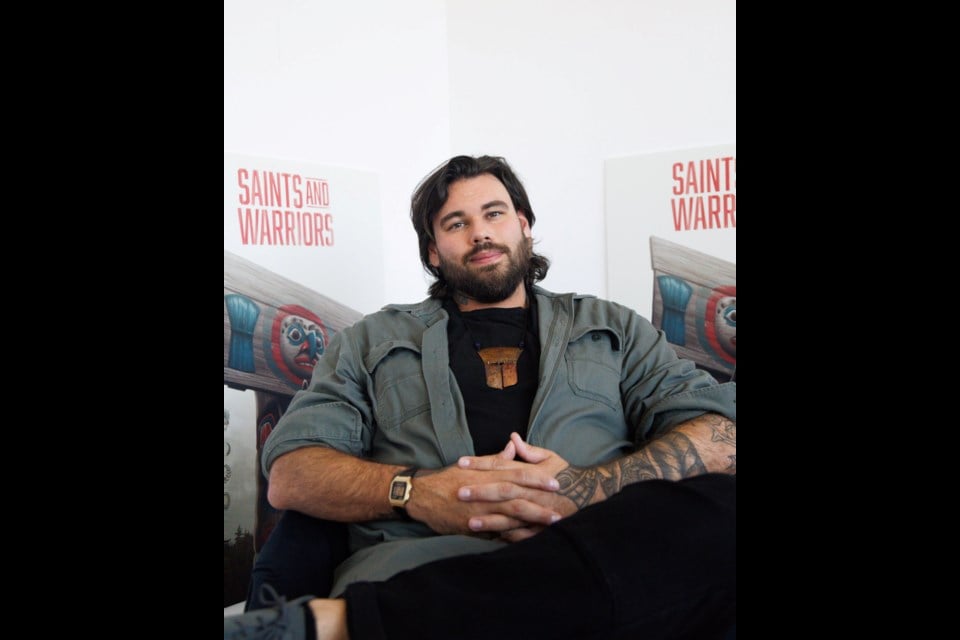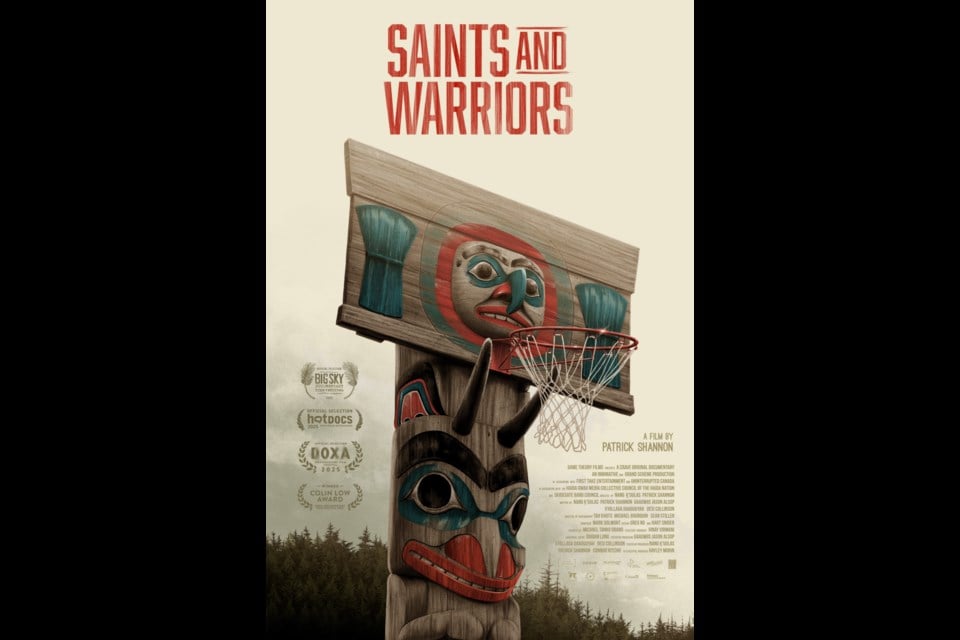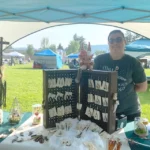Abby Luciano, Local Journalism Initiative Reporter, North Shore News
A Northern B.C. basketball team is fighting for more than a championship title on the court.
Saints and Warriors, the debut documentary from Haida filmmaker Nang Ḵ’uulas (Patrick Shannon), captures the story of the Skidegate Saints and their journey competing in the 2024 All Native Basketball Tournament in Prince Rupert, but also the present-day fight for the Hadia Nation’s sovereignty and getting land back.
“I felt compelled to tell the story of Haida basketball because even though I didn’t play basketball growing up, it’s still something that has shaped every single person on Haida Gwaii. I knew that sports was always a great vehicle to tell a much larger story of culture revitalization, resilience and it’s also an exciting form to do it.”
Haida filmmaker Nang Ḵ’uulas (Patrick Shannon)
“I felt compelled to tell the story of Haida basketball because even though I didn’t play basketball growing up, it’s still something that has shaped every single person on Haida Gwaii,” Shannon said. “I knew that sports was always a great vehicle to tell a much larger story of culture revitalization, resilience and it’s also an exciting form to do it.”
The All Native Basketball Tournament has been on the courts for 65 years and is annually held in Prince Rupert, bringing Indigenous athletes across B.C. to show off their skills and “foster community spirit and pride.”
The senior men’s Skidegate Saints is one of the dozens of teams that compete in the annual tourney, and the squad holds an impressive track record, Shannon said.
“The story itself follows the present-day story of this legendary, dynasty team, who are kind of considered the Chicago Bulls [in] in the ’90s, but for Indigenous basketball,” he said.
“A big part of it was engaging with the community in a very meaningful and substantial way. As a very collaborative person at my core, I want to make sure that the community had the ability to have a say in how the story was represented.”
Patrick Shannon
Over the last six years, the Skidegate Saints intermediate team has won four championships, juniors with four and masters have placed in the top three and won one championship, according to the Skidegate Band Council’s website.
Shannon and the producing team worked with Skidegate Saints players and Haida Nation leaders closely for about a year to ensure they were telling their story truthfully, he said.
“A big part of it was engaging with the community in a very meaningful and substantial way,” he said. “As a very collaborative person at my core, I want to make sure that the community had the ability to have a say in how the story was represented.”
More than just a sport

The significance of basketball also runs on a deeper level – it was a way for Indigenous communities to fight against gathering laws within the Indian Act.
“Basketball became a hugely important gathering vehicle for people, especially in the ’40s, ’50s and even into the ’60s when the laws were repealed. But the pressures on our culture and our cultural practices were still really high, and so basketball came to us through these kids that went to residential school.”
Patrick Shannon
Between 1927 to 1951, it was illegal for Indigenous people to gather in groups larger than three or they would be fined or jailed. But sports were an exception, Shannon said.
“Basketball became a hugely important gathering vehicle for people, especially in the ’40s, ’50s and even into the ’60s when the laws were repealed,” he said. “But the pressures on our culture and our cultural practices were still really high, and so basketball came to us through these kids that went to residential school.”
Basketball gained popularity because of its accessibility, allowing players in a wide variety of circumstances to take part, he said. The sport made the most sense as didn’t require much special equipment, it was cheaper to play and not weather dependent.
“Indigenous communities have been the most economically depressed out of any communities within Canada since [it] began, and so just access to [many sports] was out of reach for most people. But if you have a pair of shoes, if you have a basketball, you’re pretty much good to go.”
Patrick Shannon
“Indigenous communities have been the most economically depressed out of any communities within Canada since [it] began, and so just access to [many sports] was out of reach for most people,” Shannon said. “But if you have a pair of shoes, if you have a basketball, you’re pretty much good to go.”
When completing the documentary, Shannon also realized how much Potlatch, a form of governance structure and traditional gathering for many First Nations along the Northwest Coast, intertwined with basketball in Northern B.C.
Shannon said the basketball tournament and harvest season happen at the same time, perfectly aligning with the sport.
“I think all those factors really played a big part in having basketball be the preeminent sport that has taken over, especially in the North,” he said.
Breaking damaging depictions

The filmmaker was born in Haida Gwaii and raised in Skidegate, just over 1,700 kilometres from the North Shore. He moved to North Vancouver when he was 15, where he finished high school at Carson Graham.
He picked up a camera for the first time in his photography class, where it sparked his passion for capturing images.
“Indigenous people weren’t seen as storytellers in the medium. Whenever you saw Indigenous people in media, it was depictions of what other people thought of us, or we were usually used in a tokenizing or stereotyping way that wasn’t really showing us as authentic, real people.”
Patrick Shannon
“[It] really was that exposure, spending time in the darkroom at Carson Graham, that really got me to fall in love with the art of photography, and which was a natural stepping point in the cinematography later on as I became a filmmaker years later,” Shannon said.
His film career began shortly after, when he was an extra on the set of X-Men 3 in Vancouver, and he has gone on to work on dozens of TV shows and movies as a director, writer and actor.
Shannon said when he was younger, he never imagined film was something he could pursue.
“Indigenous people weren’t seen as storytellers in the medium,” he said. “Whenever you saw Indigenous people in media, it was depictions of what other people thought of us, or we were usually used in a tokenizing or stereotyping way that wasn’t really showing us as authentic, real people.”
“I really believe that there’s a responsibility for filmmakers these days to do things not only ethically, but to do things in a way that is being a part of solutions and revitalizing culture, as opposed to holding us back and trapping us in the historical past.”
Patrick Shannon
“I really believe that there’s a responsibility for filmmakers these days to do things not only ethically, but to do things in a way that is being a part of solutions and revitalizing culture, as opposed to holding us back and trapping us in the historical past,” he said.
Since Saints and Warriors’ launch, it is up for four Leo Award nominations for best feature documentary, direction, editing and cinematography, and Shannon himself has been awarded the Colin Low Award for Best Canadian Director at the DOXA film festival last month.
The film will hit movie theatres in the fall.







